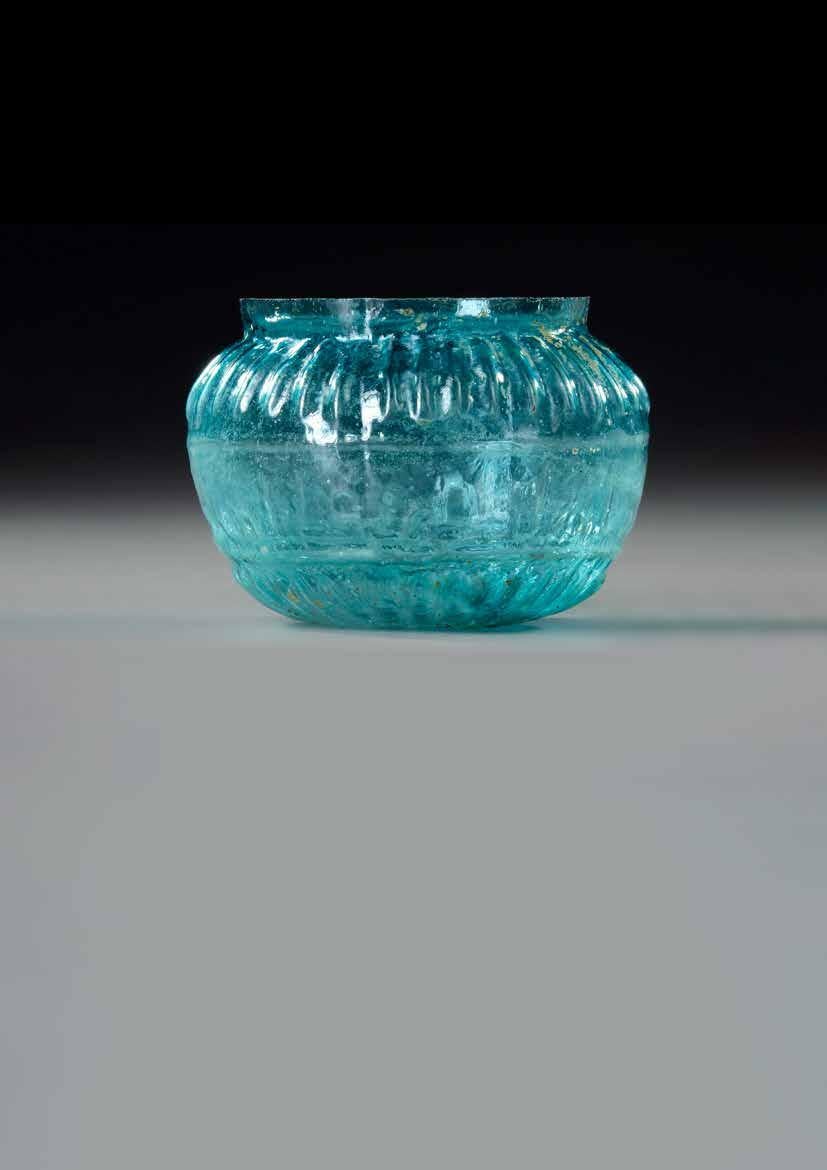
2 minute read
A KASHAN GLAZED POTTERY JUG (ALBARELLO), PERSIA, 14TH CENTURY
This medicine jar is cylindrical in shape, but with a slightly flared wall; it has a small shoulder and a straight rim, and is supported by a small annular foot. The decoration follows a precise pattern, running from the base of the body to the rim. It is made up of alternating vertical stripes in different colours (turquoise, black, cobalt blue) or decorated with pseudo-inscriptions. The cobalt-blue bands feature an arabesque of wavy lines and dots painted in black, visible beneath the blue colour. The original function of these jars was to contain spices (in Iran as early as the 9th century and in Syria a little later, from the 12th century onwards), as well as drugs and ointments used in pharmacy. Called al-birâm (earthenware pots) in Arabic, they were also very popular in Europe under their Italian name albarelli, and this albarello belongs to a group of vases consisting mainly of bowls decorated with panels radiating out from the central point, sometimes referred to as “panel style” in English. In this example, the motifs (arabesques, pseudo-calligraphy, dotted lines), colours (cream slip, black paint, cobalt blue and turquoise) and rays visible above the foot have their counterparts on the bowls, in the internal and external decoration. Despite the clear difference in appearance with the so-called Sultanabad vases, these two styles are often compared, because of the similarities in the subsidiary decorations. Panel-style vases, however, are generally finer and of higher quality.
Condition: complete, in excellent condition despite a few cracks. The paint is partially iridescent or faded, but the main lines of the decoration are nevertheless clear.
Advertisement
Height: 22 cm.
Provenance
Private collection, Switzerland
Formerly Japanese collection, collected in the 1980-90s
Bibliography
Lands of Islam, The Middle Eastern ceramic collections of the Ariana Museum in Geneva, Geneva, 2014, nos. 73-77, p. 86-89.
WATSON O, Ceramics from the Islamic Lands, Kuwait National Museum: The Al-Sabah Collection, London, 2004, pp. 388-389.
Estimate € 20.000 - € 30.000
Lot 52
A PRAYER BOOK, PROBABLY LUCKNOW, 1194 AH/1780 AD
Persian manuscript on cream paper, 26 leaves with 11 lines of black nastaliq, headings in gold, copious gold and polychrome floral illumination throughout, final folio with colophon signed by Hasan for his father Nawab Sayyid Muhammad Reza Khan Mubariz al Mulk in the year 1194 (abjad). Gold lacquer binding.
Folio: 22.3 by 15.7 cm.
Estimate € 20.000 - € 30.000
Lot 53
NASAIH HKIMA OR WISE ADVICES BY IBN AL-TUFA’LI
PERSIA, QAJAR DATED 1241 AH/1825 AD
ALI MUHAMMAD
Persian manuscript on paper, 12 leaves with 3 fly-leaves , each page with 7 lines written in black nastaliq script in clouds reserved against a sprinkled gold ground, catchwords and titles in red and gilt ink, ruled in blue and double gold borders. Opening biofolio with royal blue and gilt decoration framing 4 lines, the broad margin embellished with elegant birds perched amongst flower branches, with ownership statements and seals. The final page signed in red ink with Ibn al-Tufa’li Ali Muhammad 1241 AH/1825 AD. In Qajar lacquer binding, each board decorated with a central medallion enclosing a nightingale perching on branches with a border of floral motifs.

This book contains 40 advices on morality and etiquette, thinking about the consequences of your actions, returning to Allah and his messenger, honoring the parents, choosing the righteous friends, the four reasons for happiness and the principles of pure heart and pure hands.
Text panel: 10.5 by 17 cm.
Folio: 15.5 by 25 cm.
Estimate € 10.000 - € 20.000
Lot 54
NIZAMI (d.1209), KHAMSA, COPIED BY MAHMOUD IBN ISHAQ (ISAAC)

AL-SHIHABI, PERSIA TIMURID, DATED 920 AH/1514 AD
Poetry. Persian manuscript on paper, 45 leaves plus two fly-leaves of different colors, each folio with 10 lines of black nastaliq script arranged in two columns between black-ruled gold intercolumnar divisions, text within black-ruled gold frame, eight finely illuminated headings in gold and polychrome, opening bifolio with extensive illumination in gold and polychrome, the margins sprinkled with gold, the final folio signed by Mahmoud Ibn Ishaq Al-Shihabi and dated 920 AH. In gilt black leather binding decorated with a central panel enclosing floral motifs.
Text panel: 7.5 by 14 cm.
Folio: 14 by 24 cm.
Estimate € 20.000 - € 30.000
Lot 55










